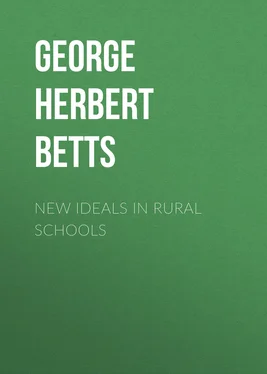George Herbert Betts - New Ideals in Rural Schools
Здесь есть возможность читать онлайн «George Herbert Betts - New Ideals in Rural Schools» — ознакомительный отрывок электронной книги совершенно бесплатно, а после прочтения отрывка купить полную версию. В некоторых случаях можно слушать аудио, скачать через торрент в формате fb2 и присутствует краткое содержание. Жанр: foreign_antique, pedagogy_book, foreign_edu, на английском языке. Описание произведения, (предисловие) а так же отзывы посетителей доступны на портале библиотеки ЛибКат.
- Название:New Ideals in Rural Schools
- Автор:
- Жанр:
- Год:неизвестен
- ISBN:нет данных
- Рейтинг книги:4 / 5. Голосов: 1
-
Избранное:Добавить в избранное
- Отзывы:
-
Ваша оценка:
- 80
- 1
- 2
- 3
- 4
- 5
New Ideals in Rural Schools: краткое содержание, описание и аннотация
Предлагаем к чтению аннотацию, описание, краткое содержание или предисловие (зависит от того, что написал сам автор книги «New Ideals in Rural Schools»). Если вы не нашли необходимую информацию о книге — напишите в комментариях, мы постараемся отыскать её.
New Ideals in Rural Schools — читать онлайн ознакомительный отрывок
Ниже представлен текст книги, разбитый по страницам. Система сохранения места последней прочитанной страницы, позволяет с удобством читать онлайн бесплатно книгу «New Ideals in Rural Schools», без необходимости каждый раз заново искать на чём Вы остановились. Поставьте закладку, и сможете в любой момент перейти на страницу, на которой закончили чтение.
Интервал:
Закладка:
In financial support the rural school has of necessity been behind the city school . Wealth is not piled up on a small area in agricultural communities as is the case in the city. It would often require square miles of land to equal in value certain city blocks. But making full allowance for this difference, the farmers have not supported their schools as well as is done by the patrons of town and city schools. The school taxes for rural districts are much lower than in city districts, in most instances not more than half as high. It is this conservatism in expenditure that is responsible for many of the defects in the rural school, and particularly for the relatively inefficient teaching that is done. The rural teachers are the least educated, the least experienced, and the most poorly paid of any class of our teachers. They consist almost wholly of girls, a large proportion of whom are under twenty years of age, and who continue teaching not more than a year or two. Not only is this the case, but effective supervision of the teaching is wholly impossible because of the large area assigned to the county or district superintendent of rural schools. In no great industrial project should we think of placing our youngest and most inexperienced workers in the hardest and most important positions, and this without supervision of their work.
The rural school has not, therefore, yet been adjusted to its problem. It has a splendid field of work, but is not developing it. Our farming population have capacity for education and need it, but they are not securing it. There is plenty of money available for the support of the rural school, but the school is not getting it. Enough well-equipped teachers can be had for the rural schools, but the standards have not yet required adequate preparation, nor the pay been sufficient to warrant extensive expenditure for it.
In the rural school is found the most important and puzzling educational problem of the present day. If our agricultural population are not to fall behind other favored classes of industrial workers in intelligence and preparation for the activities that are to engage them, the rural school must begin working out a better adjustment to its problem. Its curriculum must be broader and richer, and more closely related to the life and interests of the farm. The organization of the school, both on the intellectual and the social side, must bring it more closely into touch with the interests and needs of the rural community. The support and administration of rural education must be improved. Teachers for the rural schools must be better educated and better paid, and their teaching must be correspondingly more efficient. The following pages will be given to a discussion of these problems of adjustment.
II
THE SOCIAL ORGANIZATION OF THE RURAL SCHOOL
Every school possesses two types of organization: (1) an intellectual organization involving the selection and arrangement of a curriculum, and its presentation through instruction; and (2) a social organization involving, on the one hand, the inter-relations of the school and the community, and on the other the relations of the pupils with each other and the teacher.
The rural school and the community
The rural school and community are not at present in vital touch with each other. The community is not getting enough from the school toward making life larger, happier, and more efficient; it is not giving enough to the school either in helpful coöperation or financial support.
In general, it must be said that most of our rural people, the patrons of the rural school, have not yet conceived education broadly. They think of the school as having fulfilled its function when it has supplied the simplest rudiments of reading, writing, and number. And, naturally enough, the rural school has conceived its function in the same narrow light; for it is controlled very completely by its patrons, and a stream cannot rise higher than its source.
Because of its isolation, the pressing insistence of its toil, and the monotony of its environment, the rural community is in constant danger of intellectual and social stagnation. It has far more need that its school shall be a stimulating, organizing, socializing force than has the town or city. For the city has a dozen social centres entirely outside the school: its public parks, theatres, clubs, churches, and streets, even, serve to stimulate, entertain, and educate. But the rural community is wanting in all these social forces; it is lacking in both intellectual and social stimulus and variety.
One of the most pressing needs of country districts is a common neighborhood center for both young and old, which shall stand as an organizing, welding, vitalizing force, uniting the community on a basis of common interests and activities. For while, as we have seen, the rural population as a whole are markedly homogeneous, there is after all but little of common acquaintanceship and mingling among them. Thousands of rural families live lives of almost complete social isolation and lack of contact with neighbors.
This condition is one of the gravest drawbacks to farm life. The social impulse and the natural desire for recreation and amusement are as strong in country boys and girls as in their city cousins, yet the country offers young people few opportunities for satisfying these impulses and desires. The normal social tendencies of youth are altogether too strong to be crushed out by repression; they are too valuable to be neglected; and they are too dangerous to be left to take their own course wholly unguided. The rural community can never hope to hold its boys and girls permanently to the life of the farm until it has recognized the necessity for providing for the expression and development of the spontaneous social impulses of youth.
Furthermore, the social monotony and lack of variety of the rural community is a grave moral danger to its young people. It is a common impression that the great city is strewn thick with snares and pitfalls threatening to morals, but that the country is free from such temptations. The public dance halls and cheap theaters of the city are beyond doubt a great and constant menace to youthful ideals and purity. But the country, going to the opposite extreme, with its almost utter lack of recreation and amusement places, offers temptations no less insidious and fatal.
The great difficulty at this point is that young people in rural communities are thrown together almost wholly in isolated pairs instead of in social groups; and that there are no objective resources of amusement or entertainment to claim their interest and attention away from themselves. They are freed from all chaperonage and the restraints of the conventions obtaining in social groups at the very time in their lives when these are most needed as steadying and controlling forces. The result is that the country districts, which ought to be of all places in the world the freest from temptation and peril to the morals of our young people, are really more dangerous than the cities. The sequel is found in the fact that a larger proportion of country girls than of city girls go astray. Nor is the rural community more successful in the morals of its boys than its girls. In other words, the lack of opportunities for free and normal social experience, the consequent ignorance of social conventions, and the absence of healthful amusement and recreation, make the rural community a most unsafe place in which to rear a family.
Конец ознакомительного фрагмента.
Текст предоставлен ООО «ЛитРес».
Прочитайте эту книгу целиком, на ЛитРес.
Читать дальшеИнтервал:
Закладка:
Похожие книги на «New Ideals in Rural Schools»
Представляем Вашему вниманию похожие книги на «New Ideals in Rural Schools» списком для выбора. Мы отобрали схожую по названию и смыслу литературу в надежде предоставить читателям больше вариантов отыскать новые, интересные, ещё непрочитанные произведения.
Обсуждение, отзывы о книге «New Ideals in Rural Schools» и просто собственные мнения читателей. Оставьте ваши комментарии, напишите, что Вы думаете о произведении, его смысле или главных героях. Укажите что конкретно понравилось, а что нет, и почему Вы так считаете.











